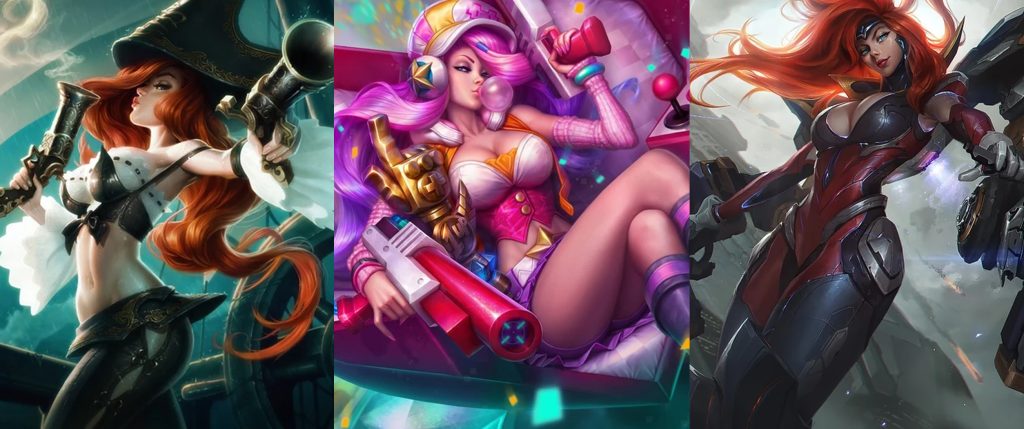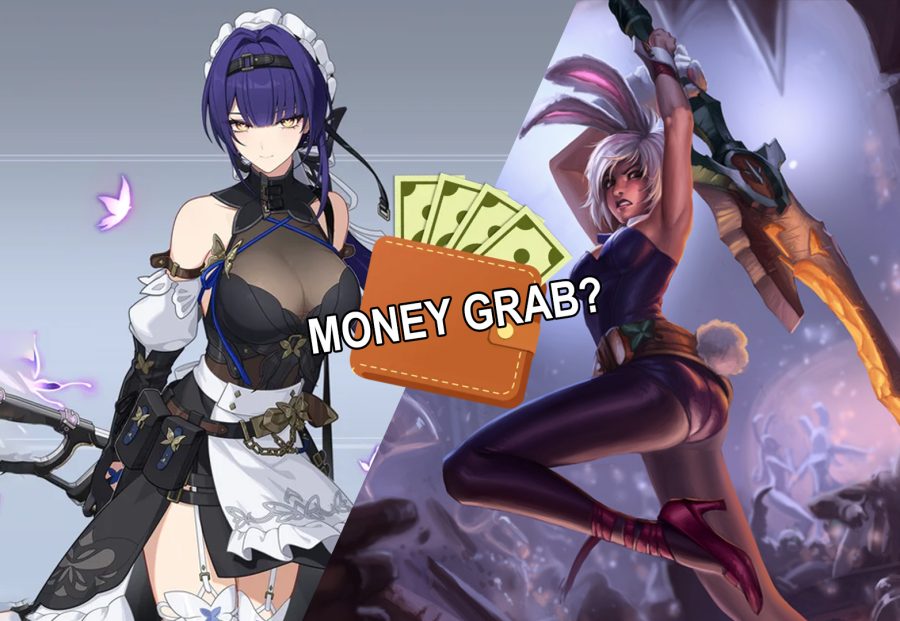What is the male gaze?
From the male viewer, women are presented as objects, tools for visual pleasure, designed to cater to a heterosexual male audience. This value is often tied to women’s appearance because of their beauty. The idea comes from the work of a film critic called Laura Mulvey, focusing on women’s looks rather than their role in the movie.
As for video games, the male gaze is introduced with female characters wearing more revealing outfits, designed in a way to catch the attention of a male audience to please their needs. This has been a big feature of gaming for quite some time; whether you are a gamer, developer or just someone who is interested of how women are represented in video games, I am about to unpack some examples from current and previous titles.
League of Legends
Released on 27th October 2009, this game provided early concepts of the male gaze in the world of gaming, with very revealing splash art of champions. Characters have revealing outfits emphasising their bodies, prioritising working on their looks that had nothing to do with their lore.
Miss Fortune

I noticed how revealing her skins can be, having a majority of her upper body exposed, sexualising their looks for the male audience. Her breasts are not only oversized in the base skin, but her other outfits are behind a paywall; splash arts continue the trend of oversized breasts, and revealing skin for pleasure. Laura Mulvey has discussed about the male gaze in film, suggesting to focus on the body of the woman than their thoughts and feeling in the story; League of Legends has proven her theory not just in film, but on video game art to attract the audience by focusing on Miss Fortunes as a sexy pirate.
Strinova
Announced in early 2024, the game had been functioning in China, following a later release globally on November 21st 2024. Laura Mulvey’s theory can still be applied to the present day, with a majority of cosmetics and character models being sexualised in a way for the audience to bring out their wallets to splash some cash.
Characters
Exaggerated breast movement is typically to draw the attention to the character’s chest. This is emphasise the fact that players choose the looks of a character than their skill set of abilities neither role within the game.

Maid outfits were traditionally worn by household workers and were designed to help identify a specific individual within the workspace. Due to Japanese media, the outfits were sexualised in a style to become more revealing, featuring a shorter skirt alongside a more revealing top. The idea behind this was to fantasise about a cute and sexy look. The audience enjoys the aesthetic, humorous and fun design, making their gaming experience more pleasurable.
The male gaze can still be seen in the present day as it is a cultural trend to boost engagements and sales in return for profits. Only time will tell if this money grab tactic would still be viable in the future.
References:
(Bonny Murphy, 2024, Sexualisation in Gaming: The Problem with MOBA Characters) – https://www.uccuniversityexpress.com/latestissue/sexualisation-in-gaming-the-problem-with-moba-characters
(Media Studies, The Male Gaze) – https://media-studies.com/male-gaze/
(Hannah Wilson, 2024, Why Are Maid Outfits Sexualized? Unpacking History and Cultural Influences) – https://sparklymaid.com/blog/why-are-maid-outfits-sexualized


Your blog on gaming and ‘Male Gaze’ is excellent and engaging, You’ve explained Mulvey’s theory clearly, so audiences that don’t know the theory will clearly understand and this understanding is deepened by associating it with a familiar piece of media. In your blog, you have made me realise how much sexualisation of women is in video games as it is so normalised the audience is basically blind to this. The examples within the blog present the theory accurately.
For improvements, try to include references throughout your blog so the audience knows where you have used the references included at the bottom. Also, to be safe, reference the images you used in the blog. Your references also need to be in alphabetical order.
Overall, your blog is easy to follow and audiences that don’t know the theory would gain huge knowledge from your blog. The referencing is the only little improvement on your blog, but apart from that, your blog is amazing.
Appreciated for the feedbackčĹŹWill keep that in mind
I agree with this blog effectively explores how the male gaze shapes the portrayal of female characters in video games, extending Laura MulveyÔÇÖs theory beyond film. It highlights how games like League of Legends and Strinova use overly sexualized designs, such as revealing outfits and exaggerated body movements, to cater to a heterosexual male audience. These portrayals prioritize visual appeal over character depth or functional roles, reinforcing harmful stereotypes about women.
The blog also underscores the financial motives behind this trend, as sexualized aesthetics are often used as a marketing strategy to boost engagement and sales. Examples like maid outfits in Strinova illustrate how cultural norms and profit-driven decisions perpetuate these designs.
Overall, the blog effectively critiques this outdated trope, calling attention to the need for more inclusive and balanced representations of women in gaming. It raises an important question about whether the industry will evolve or remain bound to these profit-driven portrayals.
Hi! I loved reading your blog post. I think this idea perfectly encapsulates how the profit incentives keeps the male gaze ever present in media. We know that these skins end up turning some form of profit for the companies that make them, if not a super large profit depending on the game. And sure, some of the objectification of women present within these skins is bound to be implicit on the creators end. But on a greater level, the creators now know that these objectifying skins churn out the highest profit and thus they continue to make them. In other words, objectation equals profit and in a world where profit is placed above everything else objection and the male gaze seems to be omnipresent. How do you suggest we stop that? Of course, we can hope that the creators become morally upstanding people. But I think in a capitalist society that is a false hope. Instead I’d argue is figuring out a way to get the public as a whole to not only think the male gaze is bad (I’d argue most already do), but to be able to recognize it and care enough to stop it. Do you have any ideas in that regard?
You provided a fresh perspective on the concept of the male gaze, focusing on how gaming companies profit from it and linking it to Mulvey’s theory, which explains how women are often designed to cater to male desires. Your use of popular characters like Miss Fortune and Strinova effectively supports your argument. Unfortunately, the trend of pandering to male aesthetics persists in today’s gaming companies, though people are increasingly recognizing this behavior as a form of stigmatization against women. I suggest you consider adding some recent examples for comparison to highlight the efforts gaming companies have made in recent years toward diversity and gender equality.